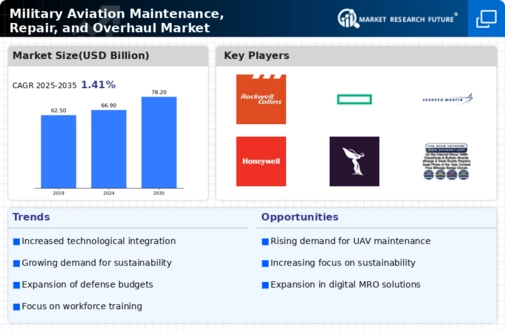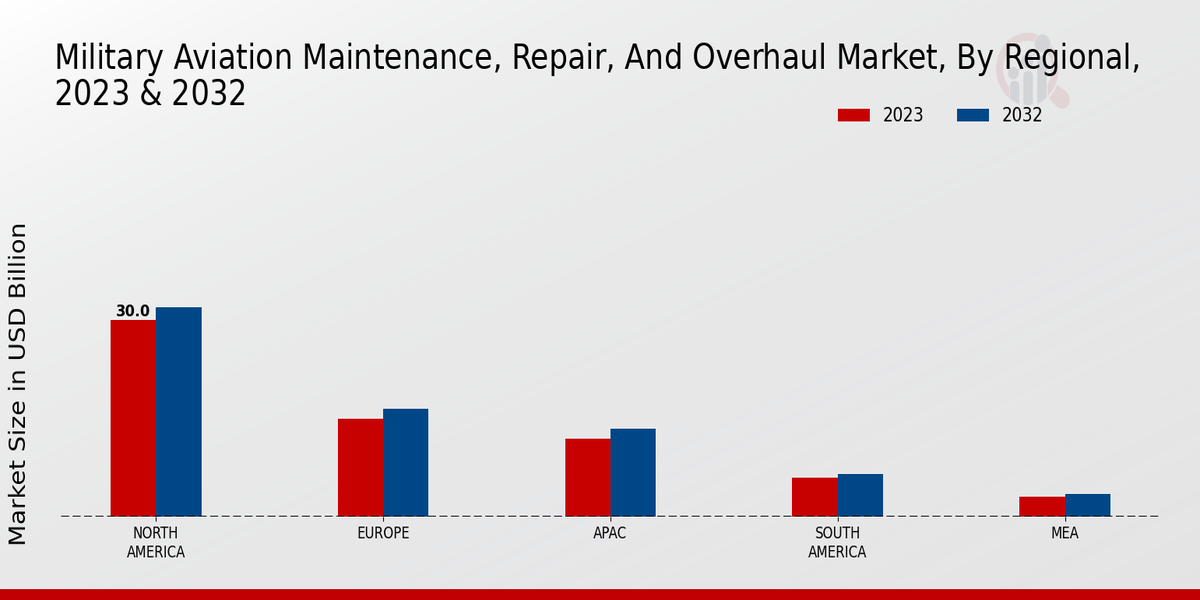Aging Aircraft Fleet
The aging aircraft fleet within military forces is a significant driver of the Global Military Aviation Maintenance, Repair, and Overhaul Market Industry. Many countries are operating older aircraft that require extensive maintenance and upgrades to remain operational. This trend necessitates a robust MRO framework to ensure safety and reliability. As aircraft age, the frequency of repairs and overhauls increases, leading to higher demand for specialized services. The need to extend the lifespan of existing fleets is expected to sustain the market's growth, as military organizations invest in MRO capabilities to address the challenges posed by aging assets.
Geopolitical Tensions
Geopolitical tensions around the world are influencing the Global Military Aviation Maintenance, Repair, and Overhaul Market Industry. Heightened security concerns and regional conflicts prompt nations to enhance their military readiness, which in turn drives the demand for MRO services. Countries are increasingly focused on maintaining operational capabilities to respond to potential threats. This has led to increased spending on military aviation maintenance and repair, as governments prioritize the upkeep of their fleets. As geopolitical dynamics evolve, the MRO market is likely to see sustained growth, reflecting the need for preparedness in an uncertain global landscape.
Market Growth Projections
The Global Military Aviation Maintenance, Repair, and Overhaul Market Industry is projected to experience steady growth over the coming years. With a market value of 66.9 USD Billion in 2024, it is expected to reach 78.2 USD Billion by 2035, reflecting a compound annual growth rate of 1.43% from 2025 to 2035. This growth trajectory indicates a sustained demand for MRO services driven by various factors, including technological advancements, aging aircraft fleets, and geopolitical tensions. The market's expansion underscores the importance of maintaining military aviation capabilities in an increasingly complex global environment.
Increasing Defense Budgets
The Global Military Aviation Maintenance, Repair, and Overhaul Market Industry is experiencing growth driven by rising defense budgets across various nations. Countries are prioritizing military readiness and modernization, leading to increased investments in aviation maintenance and repair. For instance, in 2024, the market is projected to reach 66.9 USD Billion, reflecting a commitment to maintaining operational capabilities. This trend is particularly evident in regions such as North America and Asia-Pacific, where governments are enhancing their military infrastructure. As nations seek to bolster their defense capabilities, the demand for MRO services is expected to rise, contributing to the overall growth of the industry.
Technological Advancements
Technological advancements play a crucial role in shaping the Global Military Aviation Maintenance, Repair, and Overhaul Market Industry. Innovations such as predictive maintenance, advanced diagnostics, and automation are enhancing the efficiency and effectiveness of MRO operations. These technologies enable military organizations to reduce downtime and improve aircraft availability. For example, the integration of artificial intelligence and machine learning in maintenance processes allows for more accurate forecasting of maintenance needs. As these technologies continue to evolve, they are likely to drive the demand for sophisticated MRO solutions, thereby contributing to the projected market growth to 78.2 USD Billion by 2035.
Regulatory Compliance and Safety Standards
Regulatory compliance and safety standards are critical factors impacting the Global Military Aviation Maintenance, Repair, and Overhaul Market Industry. Governments impose stringent regulations to ensure the safety and reliability of military aircraft. Compliance with these regulations necessitates regular maintenance and inspections, thereby driving demand for MRO services. As military organizations strive to meet evolving safety standards, they are likely to invest in comprehensive maintenance programs. This focus on compliance not only enhances operational safety but also contributes to the overall growth of the MRO market, as organizations seek to adhere to regulatory requirements.













